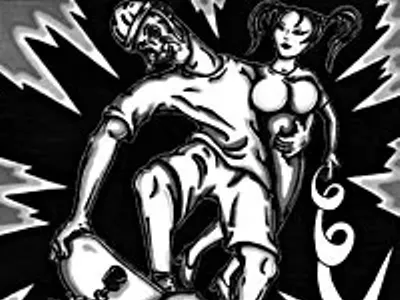Trimly dressed 24-year-old Hugh Cleal has been a house DJ for the past eight years, and has a special knack for throwing underground parties. As the former guru behind the late ’90s “/syn-de-kat/” raves in some of Detroit’s most cavernous warehouses, Cleal has a true passion for music.
Not your typical car salesman.
“I sell cars to people that I used to DJ with all the time,” says Cleal, who works at Suburban Scion in Troy. “And I never wanted to be a car salesman, either — but Scion is essentially a car for young creative people so really it sells itself.”
Cleal’s youth and exuberance are part of a radical shake-up happening in Toyota showrooms across the country. Scion, a subsidiary of Toyota Motor Corp., is marketing its sharp-edged subcompact that’s making waves with younger car buyers. Its appeal revolves around individuality — the company encourages owners to “trick out” their Scions with graphics and super stereo systems with special add-on packages.
It’s one of the biggest gambles taken by a major auto company in years, one that top executives at Toyota say they couldn’t afford to overlook.
Several years ago, some Toyota execs realized the Japanese automaker had a dodgy image with America’s youth. Sure, the baby boomer generation has flocked to Toyota (and its subsidiary, Lexus) over the past 25 years, but younger car buyers have been looking elsewhere. Toyota’s average customer age is 47, older than the industry average and rivals Nissan, Honda and Volkswagen.
In June 2003, Toyota launched the Scion in an attempt to lure Generation Y consumers into its showrooms. Marketed specifically to the 18- to 30-year-old “trendsetters,” Scion hopes to capture the buying power of the 65 million Americans who will make up a large chunk of the U.S. vehicle market by the year 2010.
To do this, Scion treads where no previous automaker had truly gone before: into the hip-hop and underground music cultures of today’s youth.
“They’ve been very up-front about breaking all the rules of car marketing from the beginning,” says Raymond Roker, owner of both Urb Magazine and the Rebel Organization that heads Scion’s urban marketing efforts.
Roker says Scion first contracted with his company in 2001 to reach further into Generation Y’s home turf. The crux of Scion’s marketing focuses on the underground music and artistic cultures that many automakers are choosing to ignore.
“Scion’s marketing campaign is turning out to be a huge success,” says Todd Lassa, Detroit editor of Motor Trend. “I originally wrote a column two years ago criticizing Toyota for trying to market a youth-oriented automobile, but I admit that I was wrong.”
How wrong? Scion eclipsed its sales projection for all three models in 2004, falling just shy of 100,000 units. Toyota had expected its subsidiary to sell 75,000 at best. The boxy xB is the most popular of the line, followed by the sleek two-door tC, modeled after the European Avensis. The compact xA struggled in the U.S. market, but still met expectations. All three models retail for less than $15,000. The automaker hopes that young consumers will latch onto Scion early, move to Toyota brands around middle age, and eventually climb up to Lexus.
“They give you a lot of car for a little bit of money,” says DJ Jazzy Jeff, who spins at Scion events around the country. “The hip-hop market doesn’t have a lot of money, so it makes more sense for Scion to market these affordable cars to the underground market that already rejects the bling-bling.”
Roker agrees. “The fallacy is that young people are turned off by marketing, which isn’t totally true,” Roker says. “They’re totally open to marketing that respects their community and allows them to make their own decisions.”
Rather than pumping money into TV commercials, Scion chose to build a flashy Web site and publish a free urban-culture magazine for readers. Scion also puts on a traveling art exhibit called Installation, where highly respected urban artists — among them Sam Flores, Shepard Fairey and NYC graffiti legend Futura 2000 — display original work. Scion also sponsors a variety of monthly parties around the country that pay local musicians like Ann Arbor’s DJ Graffiti a sizable stipend just to throw a hip-hop club night among friends.
“When I throw my monthly parties, no one from Scion gets on the mic and gives a 10-minute shout-out or does a lame video presentation about the car,” DJ Graffiti says. “I think the audience appreciates that.”
When Scion first unveiled this strategy to the public two years ago, auto industry experts scoffed.
Jeri Yoshizu, project coordinator for Scion, acknowledges the risk in marketing to a “below the radar” audience, but says Scion’s strength is in its boldness.
“We felt a lot of corporations were straying away from hip-hop or only focusing on the mainstream,” Yoshizu says. “So we decided to put on events featuring artists that underground hip-hop fans would recognize.”
In addition to sponsoring other DJ’s parties, Scion also throws its own hip-hop shindigs called Metro in various cities that typically feature anyone from Biz Markie and Pete Rock to Grandmaster Flash and the 45 King.
Car companies dabbling in youth marketing is nothing new. Dodge found temporary success with the Neon in the ’90s, but more so because of its affordable pricing than attractive design. The Honda Element and Pontiac Vibe have recently been marketed to younger consumers, but sales figures and demographics have been disappointing. In Michigan, the Pontiac Vibe sold a dismal 3,691 cars through September 2004, about half of what sold in 2003. The Honda Element is selling well, but its youngest buyers are around 43. The average age of Scion buyers is 36.
“Cars that don’t use the word ‘youth’ in their advertising tend to do better with young audiences,” Lassa says. Toyota tried to market the Echo to young buyers and it tanked. The Element has young surfers in its commercials, and they’ve ended up attracting more baby boomers than anything.”
Marketing to Gen Y consumers is becoming increasingly difficult.
“I see Scion as a canvas for young creativity in automotives,” Roker says. “Car culture is rooted in music culture now, in Internet culture and MTV. Detroit has no momentum to capture that audience, because car evolution has moved so far beyond them.”
Scion allows customers to go online and customize their cars, choose from more than 40 tuner accessories on the company Web site, get a price quote and present it all to the dealership without even sitting down with a salesperson. It also allows customers to fully accessorize cars under warranty — an option that impressed new Scion owner Sam Qualls, 25, of Sterling Heights. Qualls knew which Scion he wanted three months before walking into a Toyota dealership.
“I customized everything myself online, walked into the dealership and handed them my paperwork,” Qualls says. “You really have to pace yourself on the Web site; there’s so many options to choose from, it’s ridiculous.”
DJ Premier of Gangstarr, who’s been eyeing Scions for a while, offers another perspective. “The people I see driving these cars seem to be the more rebellious types, the skateboarders, the b-boys. I haven’t really seen any nerds driving a Scion yet,” Premier says by phone. “They need to give me one of those bad boys for free.”
Jonathan Cunningham is an editorial intern for Metro Times. Send comments to [email protected]





